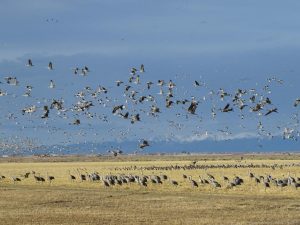Back to Innovator Next article Previous article
Written by: Haylee Archambault, on behalf of Northeastern Ontario Regional Communication Coordinator
Sandhill cranes are a migratory bird standing nearly four feet tall, with a seven-foot wingspan, and equipped with long necks, legs, and beaks. Many producers within Northern and Eastern Ontario are discontentedly familiar with these birds.
The sandhill crane typically feeds on three crop types: corn, cereals, and potatoes. Recent data collected through the Sandhill Crane Movements in Agriculture Conflicts project discloses that these birds are breeding further north than previously observed. As a result, many producers within the sandhill crane migratory route in Northern and Eastern Ontario have seen an increase in crop damages throughout planting and harvest.
There are many methods in place to adapt and mitigate this time-consuming and costly conflict. For instance, Avipel is a product used internationally as a bird deterrent for crops as well as turf grass. Seeds treated with Avipel do not taste good to the birds, so they learn to avoid it. The product is available in powdered or liquid form and has proven to prevent some of the crop damage caused by sandhill cranes. It has been effective as a seed treatment in the United States for protecting corn seed from sandhill cranes.
Even though Avipel is endorsed by the International Crane Foundation as a non-lethal mitigation device, along with its proven effectiveness in the United States for producers with crane issues, it is currently not available in Canada for regular use. However, there is a high level of interest from producers in Canada. At this time, Avipel is undergoing regulatory processes and testing within Ontario on farms in need of emergency use to be approved for regular distribution.
In the meantime, producers are taking the initiative and implementing mitigation strategies to reduce the damages caused by sandhill cranes. Producers have noticed that cranes tend to return to the same regions within the same field. As a result, the implementation of a lure crop to these regions can be used to defer the cranes from a high-value crop.
Damage or danger permits issued by the ministry are another strategy utilized by producers to lessen the damage caused by cranes. Types of permit requests include scare using firearms, kill to scare, kill, relocation, disposal of eggs, and removal of nests. Permits are an effective tactic to remove cranes from the fields, for a short period of time. Overall, obtaining permits mitigates only a small portion of the conflict.
With continued development of adaptive and mitigation strategies, along with the implementation of Avipel research trials, Northeastern Ontario is one step closer to living harmoniously with sandhill cranes. Innovation is not only driven by technology, but also ground-breaking on-farm practices best suited to your operation, which can be applied to prevent the issue.
To keep up to date with this development, you can tune-in to the Packsack Project podcast series on Spotify, Apple Podcast, and Google Podcast.
Information within this article is sourced from the Packsack Project, a collaborative podcast from the Sault Ste. Marie Innovation Centre’s Rural Agri-Innovation Network (RAIN) and NORDIK Institute.


